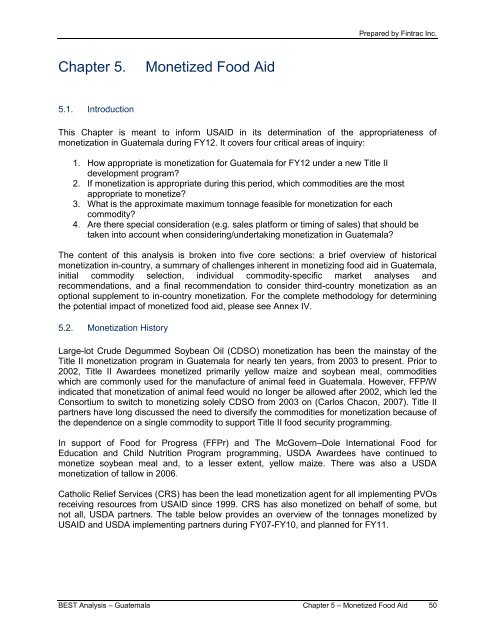usaid office of food for peace guatemala bellmon estimation
usaid office of food for peace guatemala bellmon estimation
usaid office of food for peace guatemala bellmon estimation
You also want an ePaper? Increase the reach of your titles
YUMPU automatically turns print PDFs into web optimized ePapers that Google loves.
Chapter 5. Monetized Food Aid<br />
5.1. Introduction<br />
Prepared by Fintrac Inc.<br />
This Chapter is meant to in<strong>for</strong>m USAID in its determination <strong>of</strong> the appropriateness <strong>of</strong><br />
monetization in Guatemala during FY12. It covers four critical areas <strong>of</strong> inquiry:<br />
1. How appropriate is monetization <strong>for</strong> Guatemala <strong>for</strong> FY12 under a new Title II<br />
development program?<br />
2. If monetization is appropriate during this period, which commodities are the most<br />
appropriate to monetize?<br />
3. What is the approximate maximum tonnage feasible <strong>for</strong> monetization <strong>for</strong> each<br />
commodity?<br />
4. Are there special consideration (e.g. sales plat<strong>for</strong>m or timing <strong>of</strong> sales) that should be<br />
taken into account when considering/undertaking monetization in Guatemala?<br />
The content <strong>of</strong> this analysis is broken into five core sections: a brief overview <strong>of</strong> historical<br />
monetization in-country, a summary <strong>of</strong> challenges inherent in monetizing <strong>food</strong> aid in Guatemala,<br />
initial commodity selection, individual commodity-specific market analyses and<br />
recommendations, and a final recommendation to consider third-country monetization as an<br />
optional supplement to in-country monetization. For the complete methodology <strong>for</strong> determining<br />
the potential impact <strong>of</strong> monetized <strong>food</strong> aid, please see Annex IV.<br />
5.2. Monetization History<br />
Large-lot Crude Degummed Soybean Oil (CDSO) monetization has been the mainstay <strong>of</strong> the<br />
Title II monetization program in Guatemala <strong>for</strong> nearly ten years, from 2003 to present. Prior to<br />
2002, Title II Awardees monetized primarily yellow maize and soybean meal, commodities<br />
which are commonly used <strong>for</strong> the manufacture <strong>of</strong> animal feed in Guatemala. However, FFP/W<br />
indicated that monetization <strong>of</strong> animal feed would no longer be allowed after 2002, which led the<br />
Consortium to switch to monetizing solely CDSO from 2003 on (Carlos Chacon, 2007). Title II<br />
partners have long discussed the need to diversify the commodities <strong>for</strong> monetization because <strong>of</strong><br />
the dependence on a single commodity to support Title II <strong>food</strong> security programming.<br />
In support <strong>of</strong> Food <strong>for</strong> Progress (FFPr) and The McGovern–Dole International Food <strong>for</strong><br />
Education and Child Nutrition Program programming, USDA Awardees have continued to<br />
monetize soybean meal and, to a lesser extent, yellow maize. There was also a USDA<br />
monetization <strong>of</strong> tallow in 2006.<br />
Catholic Relief Services (CRS) has been the lead monetization agent <strong>for</strong> all implementing PVOs<br />
receiving resources from USAID since 1999. CRS has also monetized on behalf <strong>of</strong> some, but<br />
not all, USDA partners. The table below provides an overview <strong>of</strong> the tonnages monetized by<br />
USAID and USDA implementing partners during FY07-FY10, and planned <strong>for</strong> FY11.<br />
BEST Analysis – Guatemala Chapter 5 – Monetized Food Aid 50

















